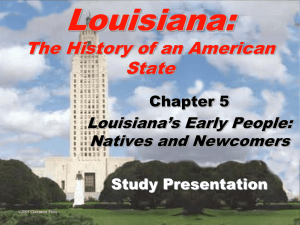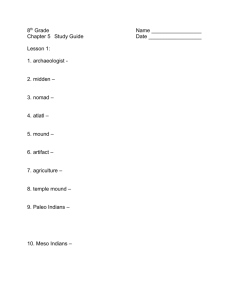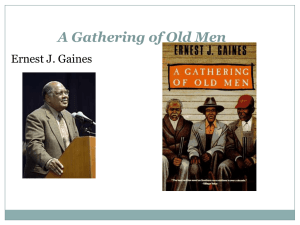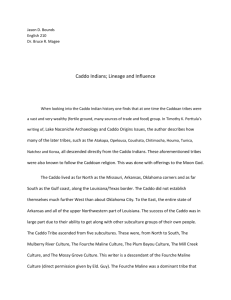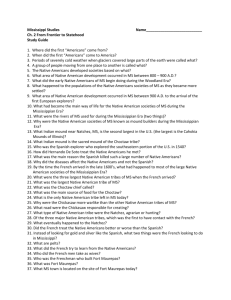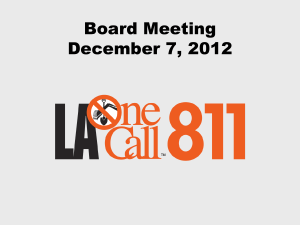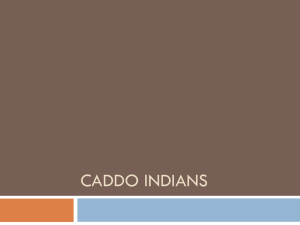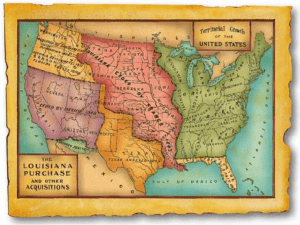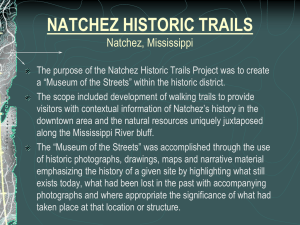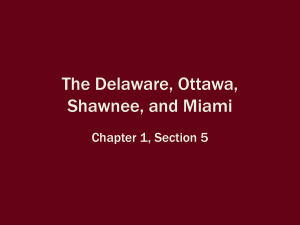Louisiana: Our History, Our Home
advertisement
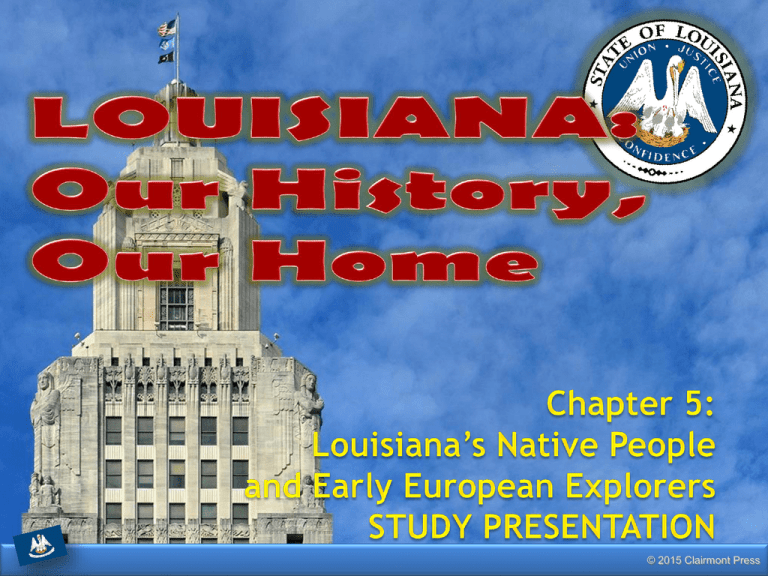
© 2015 Clairmont Press Section 1: Prehistoric Cultures Section 2: Historic Indian Tribes 2 Section 1: Prehistoric Cultures Essential Question: • What characteristics made each of the four prehistoric cultures unique? 3 Section 1: Prehistoric Cultures What terms do I need to know? • • • • • • • • • artifact prehistoric archaeologist midden nomadic atlatl mound Agriculture maize 4 Introduction The first people who lived in the area that is now Louisiana did not leave written records, but some artifacts, or the items they used in their daily lives have survived, often buried deep in the ground. Prehistoric (before the time of written history) people left behind the tools they used for hunting and making shelters. Artifacts provide archaeologists (scientists who use artifacts from the past to try to understand prehistoric people) a window into how prehistoric people lived. One place archaeologists find artifacts in large numbers is in middens (ancient garbage dumps). 5 Paleo Era The first people to live in Louisiana date to a period called the Paleo Era. Scientists believe they migrated from Asia and Siberia, beginning in 30,000 BC. They traveled in small groups and based their movements on the migration patterns of the animals they hunted. When groups of Paleo people reached Louisiana, they found animals that they needed in order to survive, as well as plants and water-based creatures they could eat. 6 Meso Era People in this time were still nomadic, but stayed in the same places for longer periods of time. The men hunted for food and the women gathered foods. They developed an atlatl (shaft of wood with a small cup for a spear) to hunt smaller, faster animals. Mesos began building mounds around 5000 BC for special ceremonies. There have been more artifacts recovered from the Meso Era than in the Paleo Era. 7 Early Neo Era The Early Neo Era began about 2000 BC. Archaeologists have found a large amount of pottery from this era. An advancement that distinguished their period is the development of the bow and arrow. People began living together in larger groups and established villages during this 2800-year period. Artist rendering of Poverty Point site about 1350 BC Poverty Point State Historic Site 8 Late Neo Era This period began about AD 800 and ended around AD 1600. The people of this time built more permanent homes and built temples on mounds for sacred ceremonies. The people of the Late Neo Era switched from gathering to agriculture, or settled farming. Their main crops were maize (corn), beans, squash, and pumpkins. They invented the method of intercropping, which is when two or more plants with different harvesting times are planted in the same plot of land. 9 Section 2: Historic Indian Tribes Essential Question: • What were the characteristics of the tribes that European explorers encountered in Louisiana? 10 Section 2: Historic Indian Tribes What terms do I need to know? • immunity • tribe • treaty 11 Introduction The shift from prehistoric to historic cultures is marked by the arrival of the written word. Explorers from Spain and France made the first written records about the life and customs of Native Americans. Unfortunately, the earliest Europeans did not understand native languages, and they misunderstood Native American customs and practices. 12 Spanish Encounters with Native Americans Spanish explorer Hernando de Soto traveled from Cuba in 1539 to look for gold in the southern region of the modern US. While the Spanish brought soldiers, horses, bloodhounds, and pigs, they also brought diseases with them. Because the natives had no immunity, or natural resistance, to European illnesses, nearly half of the Native American population died. 13 French Encounters with Native Americans The French began to explore ad settle around 1700. They came across empty villages from where the natives abandoned them when diseases swept through. French settlers and explorers identified a number of tribes. A tribe is a group of native people who share a name, common ancestry, language, and way of life. Though tribes spoke different languages, most could communicate through the common language Mobilian. 14 Historic Tribes When the French arrived in present-day Louisiana, they encountered seven major tribal groups. Many Native American tribes moved to different areas because of European settlement. Almost of Native Americans began to use European trade goods, like pots, blankets, and guns. The Atakapa and the Natchez groups ceased to exist by the 1730s. 15 Historic Tribes of Louisiana 16 Atakapa The Atakapa lived in the southwest corner of modern Louisiana. Their cannibalistic practices were used on slain enemies. The Atakapa suffered greatly from European disease, and those who survived were driven from their homes by the settlers. 17 Natchez The Natchez people lived in the Grand Village, located on the eastern bluffs above the Mississippi River. Europeans described them as fearsome warriors. They had a highly developed class structure: a king was at the top, then the nobles, then the bottom-dwellers called stinkards. The Natchez wore elaborate clothing and had tattoos. They chose their land very skillfully, but the French ordered them off of their land in 1729. The few Natchez who survived could not reestablish villages for fear of French reprisal. They became parts of other groups, like the Creek and Cherokee, and the Natchez ceased to exists. 18 Caddo The Caddo were traders, as well as farmers, that lived along the Red River. They were affected by border disputes between the French, Spanish, and later the United States. The Caddo made a treaty with the United States in 1835, trading land for money and goods. The Caddo continued to be forced from their lands, and today live together as the United Caddo Nation on a reservation in Oklahoma. They have retained many of their ancient practices. 19 Chitimacha The Chitimacha trace their origins to about AD 500. At its height, 20,000 members were spread across 15 villages. Their population dwindled due to illnesses and conflicts with the French. In 1762, Acadians settled near the Chitimacha. Over time the two groups intermarried and French became a common language. In 1917 the US recognized the Chitimacha as a sovereign Indian nation and live on a reservation near St. Mary Parish. 20 Choctaw Choctaw occupied an area that is present-day Georgia, Alabama, Mississippi, and Louisiana. An internal tribal war arose after the Choctaw split alliances between the French and British during the French and Indian War of 1763. The Choctaw agreed to cede their territory to the US in the 1830s. Today, most descendents of the Choctaw live on reservations in Oklahoma and Mississippi. Three groups of Choctaw still live in Louisiana: the Jena Band of Choctaw, the Clifton Choctaw, and the Ebarb-Choctaw-Apache tribe. 21 Houma René-Robert Cavelier encountered the Houma people on his journey down the Mississippi River in 1682. After a period of frequent moves, the Houma ended up in swamps and marshes, where hey learned to hunt, fish, and trap local animals. The crawfish is their totem symbol. The current 15,000 members of the Houma people live mainly in Terrebonne and Lafourche Parishes. The Houma are a recognized tribe by Louisiana, but they have not gained federal recognition. 22 Tunica-Biloxi Tunica-Biloxi originally lived in Mississippi and were forced inland by the French. The Tunica used their trading skills to control their relationships with the European settlers. The Tunica-Biloxi gained federal recognitions in 1986. They live on a reservation at Avoyelles Parish and govern their own affairs. 23 Coushatta The Coushatta originated in Tennessee, but they moved east to avoid further contact with the Spanish and English. About 900 Coushatta migrated to Louisiana by the early 1800s. They purchased and settled land in 1880s and remain there to this day. They received federal recognition in 1973 and became successful with their Coushatta Casino Resort. A cultural achievement of the Coushatta is weaving intricate baskets, and this is highly prized by museums and collectors. 24 Image Credits Slide 1: Chris Miceli on Wikimedia Commons, Public Domain; Slide 2: Ken Thomas (alligator); Jillian.E (Chicot State Park); City of Monroe, LA; Albert Herring (Mardi Gras), Lael Butler (pelican); Jesper Rautell Balle (cajun meal); Susan Adams (Chemin-a-Haut State Park) on Wikimedia Commons; Slide 8: Louisiana Department of Culture, Recreation, and Tourism (original by Jon Gibson); Image Credits Slide: Edd Prince on Wikimedia Commons; maps copyright Clairmont Press; all others public domain Shown here: Fontainebleau State Park Return to Main Menu 25
